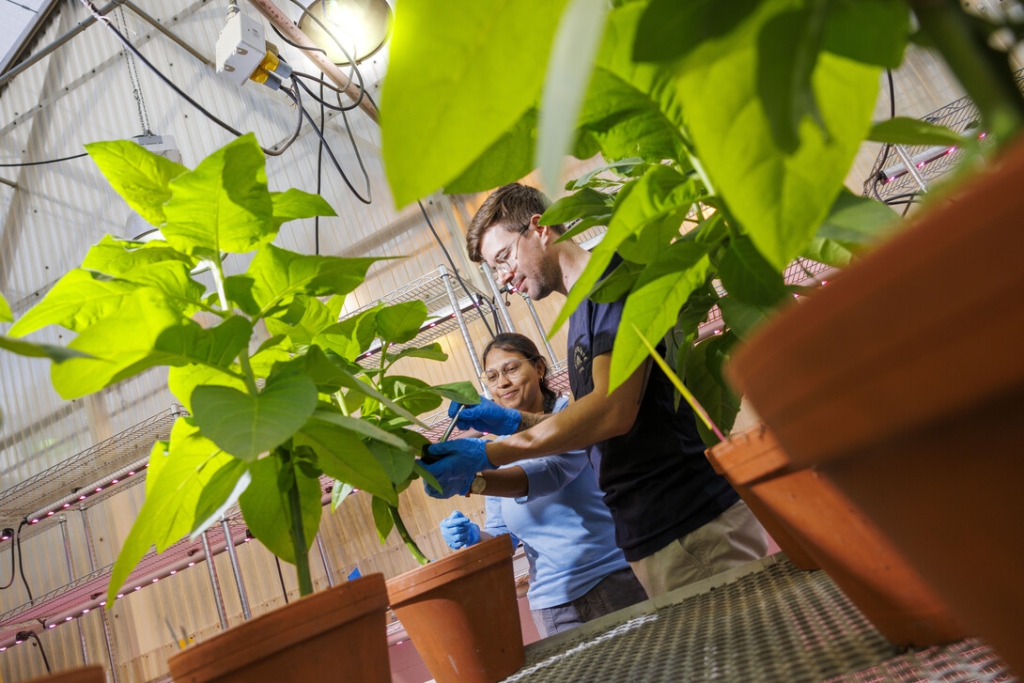Geitner Simmons, August 26, 2024
Husker research points to increased water use efficiency for crops
Scientists at the University of Nebraska–Lincoln have identified a promising approach to help crops cope with drought. By using genome modification to boost a key plant protein, the researchers enabled plants to reduce their water use by up to 30% under drought-mimic conditions.
The findings mark “an important step toward future engineering of crops with improved performance under drought,” the researchers wrote in a new article in the Journal of Experimental Botany.
Husker researchers grew tobacco plants under varying drought conditions and found that a particular genetic modification allowed the plants to use 4% to 30% less water overall than normal plants. Tobacco plants are useful for research because they generally are easy to cultivate and grow fast. Their genetic details are well known, and they lend themselves well to genetic modification, facilitating follow-up research with other, more complex crops.
“Plants are using up to 30% less water but in the end, the biomass — how big they are — is not significantly different,” said Kasia Glowacka, assistant professor of biochemistry. Her lab uses a wide range of analytical techniques for boosting crop resilience in the wake of climate stress.
Plants’ improved water use efficiency is a particular focus, which has led her lab to pursue advanced studies of non-photochemical quenching, an important safety valve biological process. Plants use the process to protect themselves from stress and harm when they receive more light energy than they can use for photosynthesis.
Non-photochemical quenching can regulate the opening of stomata, the pores by which a plant absorbs carbon dioxide (important for plant growth) while simultaneously releasing water vapor and oxygen.

Glowacka’s lab boosted the amount of PsbS, a protein involved in non-photochemical quenching. More of the protein reduces stomatal opening via increased non-photochemical quenching in response to light. The result was improved water use efficiency.
“It’s not that we are shutting down the stomata,” Glowacka said. “We are changing their behavior.”
In the new academic paper, she and her coauthors wrote that the lab’s findings provide “a proof of concept that through overexpression of PsbS it is possible to modify stomatal opening under drought conditions to achieve higher water use efficiency and reduce water consumption at the whole-plant level without significant loss of biomass.”
Plants in the project lost 11% less water for each unit of carbon dioxide they absorbed compared with normal plants, without significant effect on plant size. Given climate stresses and limited water resources for agriculture globally, progress is needed for crops that require less water per mass of yield, the researchers wrote.
The findings are “really exciting, because we don’t see a minus for the growth,” Glowacka said. “So, it’s a good starting point. It’s proof that this works.”
The next step is follow-up refining of genome modification to improve crop production under water limitation. The Glowacka Lab is currently conducting that research.
Other Husker researchers involved in the project were Geng Bai, research assistant professor with the Department of Biological Systems Engineering, and postdoctoral researchers Benjamin Turc and Seema Sahay; Jared Haupt, a Husker graduate student; and Talles de Oliveira Santos, a visiting graduate student from State University of Northern Rio de Janeiro, Brazil.
Agriculture Biochemistry Institute of Agriculture and Natural Resources





